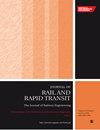高速动车组转向架失稳监测与抑制措施试验研究
IF 2.1
4区 工程技术
Q3 ENGINEERING, CIVIL
Proceedings of the Institution of Mechanical Engineers Part F-Journal of Rail and Rapid Transit
Pub Date : 2023-03-26
DOI:10.1177/09544097231160362
引用次数: 0
摘要
转向架作为轨道车辆的关键部件,其动态性能直接影响到车辆的运行性能。高速动车组在运行过程中会出现大量的转向架失稳现象,对高速动车组的安全性和乘客舒适性产生重要影响。本文采用线路试验与仿真相结合的方法研究转向架猎行,首先进行线路试验,对高速动车组的振动数据和车轮磨损演变进行测试。通过对数据的分析,找出高速动车组转向架失稳的演变规律。然后建立车辆动力学模型,找出转向架失稳的机理,最后提出抑制转向架失稳的措施。试验数据表明,机动车的车轮磨损、转向架失稳频率和幅值均大于挂车,平顺性指标较差。车轮改型前后的平顺性指标均不超过2.5。等效锥度增大是引起转向架失稳的主要原因,通过车轮重仿形、更换偏航阻尼器和钢轨磨削可以有效地抑制转向架失稳。本文章由计算机程序翻译,如有差异,请以英文原文为准。
Experimental study of bogie instability monitoring and suppression measures for high-speed EMUs
As the key part of the rail vehicle, the bogie’s dynamic performance directly affects the vehicle’s operating performance. A large number of bogie instability phenomena occur during the operation of high-speed Electric Multiple Units (EMUs), which has an important impact on the safety and passenger comfort of the high-speed EMUs. In this paper, through a combination of line tests and simulations to study bogie hunting, line tests are first conducted to test the vibration data and wheel wear evolution of the high-speed EMUs. The data was analyzed to find out the evolution of the bogie instability law of the high-speed EMUs. Then the vehicle dynamic model is established to find out the mechanism of the bogie instability, and finally bogie instability suppression measures are proposed. The results of the test data showed that the wheel wear, the frequency and the amplitude of bogie instability of motor car is greater than that of the trailer car, and the ride index is poorer. The ride indexes at the early and late stages after wheel re-profiling do not exceed 2.5. The equivalent conicity increase is the main cause of bogie instability, and the bogie instability can be effectively suppressed by wheel re-profiling, replacing the yaw damper, and the rail grinding.
求助全文
通过发布文献求助,成功后即可免费获取论文全文。
去求助
来源期刊

CiteScore
4.80
自引率
10.00%
发文量
91
审稿时长
7 months
期刊介绍:
The Journal of Rail and Rapid Transit is devoted to engineering in its widest interpretation applicable to rail and rapid transit. The Journal aims to promote sharing of technical knowledge, ideas and experience between engineers and researchers working in the railway field.
 求助内容:
求助内容: 应助结果提醒方式:
应助结果提醒方式:


